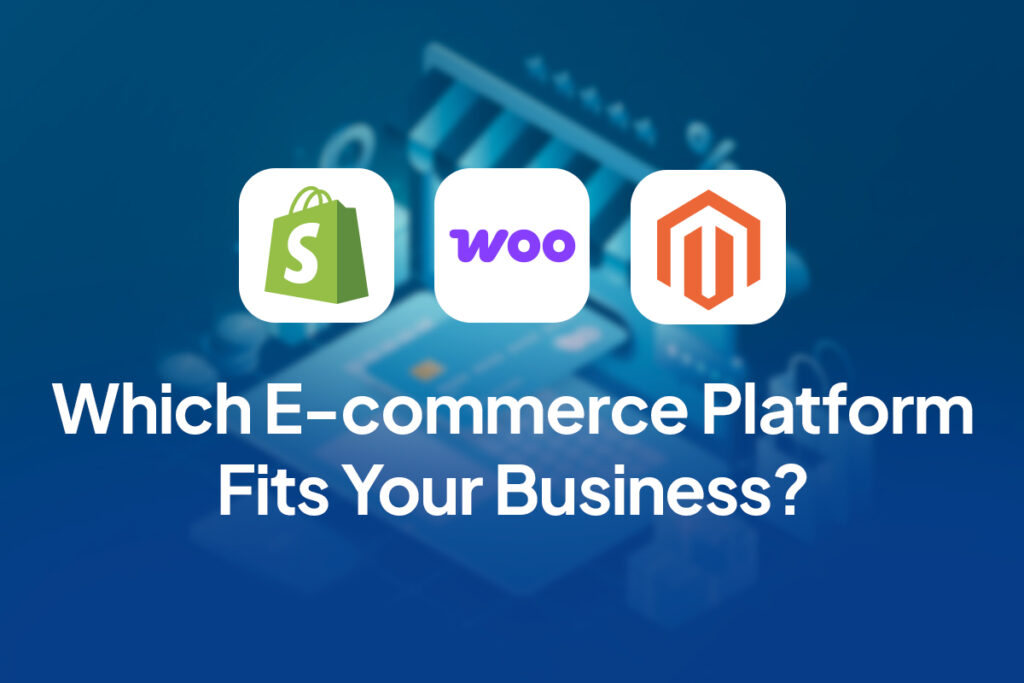Shopify vs WooCommerce vs Magento E-commerce Platform Comparison

Choosing the right e-commerce platform can make or break your online business success. With Shopify taking 26% and WooCommerce holding a middle ground at a 20% market share, these platforms dominate the e-commerce landscape alongside Magento. But which one is right for your business? This comprehensive comparison analyzes Shopify, WooCommerce, and Magento across the most critical factors: features, costs, scalability, and performance. Whether you’re launching your first online store or migrating from an existing platform, this guide will help you make an informed decision based on your specific business needs and budget. Platform Overview Shopify: The All-in-One Solution Shopify is a fully-hosted, cloud-based e-commerce platform designed for ease of use. Shopify is a more user-friendly platform that is perfect for smaller businesses that wish to start an eCommerce website without committing too much time, money and effort. The platform handles hosting, security, and updates automatically, making it ideal for entrepreneurs who want to focus on selling rather than technical management. WooCommerce: The WordPress-Powered Option WooCommerce is not a full-fledged CMS, but just an e-commerce plugin for WordPress. But this doesn’t make it any less powerful. WooCommerce is most suitable for businesses that are already running a WordPress-based website and wish to enrich it with e-commerce functionality. As an open-source solution, it offers extensive customization possibilities. Magento: The Enterprise Powerhouse Magento was released in 2008. It was acquired by Adobe Inc. in 2018. Magento offers better performance, security, and ease of use. Compared to WooCommerce and Shopify, Magento is more feature-rich. If you’re running a medium-to-large e-commerce business or have extensive operations in multiple industries, Magento is the standout choice. Pricing and Cost Comparison Shopify Pricing Structure The plans include Basic ($39), Shopify ($105), and Advanced ($399). Each plan comes with a monthly (or yearly, with 25% off) subscription fee, and pricing is tiered based on the features and capabilities offered. Detailed Shopify Pricing: Total Cost of Ownership: Shopify’s pricing is predictable, with all hosting, security, and basic features included. However, premium apps and themes can increase costs significantly. WooCommerce Pricing Structure WooCommerce is a free, open-source plugin for WordPress. However, the “free” nature can be misleading when you factor in additional costs: WooCommerce Cost Breakdown: Total Cost of Ownership: While initially appearing cheaper, WooCommerce’s total costs can rival or exceed Shopify when accounting for hosting, plugins, themes, and development time. Magento Pricing Structure Magento offers two main versions with different pricing models: Magento Open Source (Free) Adobe Commerce (Magento Enterprise) Total Cost of Ownership: Magento requires significant upfront investment and ongoing maintenance costs, making it suitable primarily for large enterprises with substantial budgets. Feature Comparison (Icons of app/plugins of : Shopify, WordPress, Magento.) Ease of Use and Setup Customization and Flexibility Extension and App Ecosystem SEO Capabilities Scalability and Performance Traffic and Transaction Handling Multi-Store Management International and Multi-Currency Support Security and Maintenance Security Features Maintenance Requirements When to Choose Each Platform Choose Shopify If: Choose WooCommerce If: Choose Magento If: Making Your Decision The choice between Shopify, WooCommerce, and Magento ultimately depends on your business size, technical expertise, budget, and growth plans. Consider starting with a platform that meets your immediate needs while ensuring it can scale with your growth. Many successful businesses begin with Shopify or WooCommerce and migrate to more robust solutions as they expand. The Wrap-up Each platform has distinct advantages depending on your business context. Shopify excels in user-friendliness and reliability, WooCommerce offers flexibility and cost-effectiveness, while Magento provides enterprise-grade power and customization. Evaluate your priorities: if you value simplicity and support, choose Shopify; if you need flexibility on a budget, select WooCommerce; if you require enterprise features and have the resources, opt for Magento. Remember that switching platforms later is possible but can be costly and time-consuming. Invest time in evaluating your long-term needs and choose the platform that best aligns with your business goals and technical capabilities.
